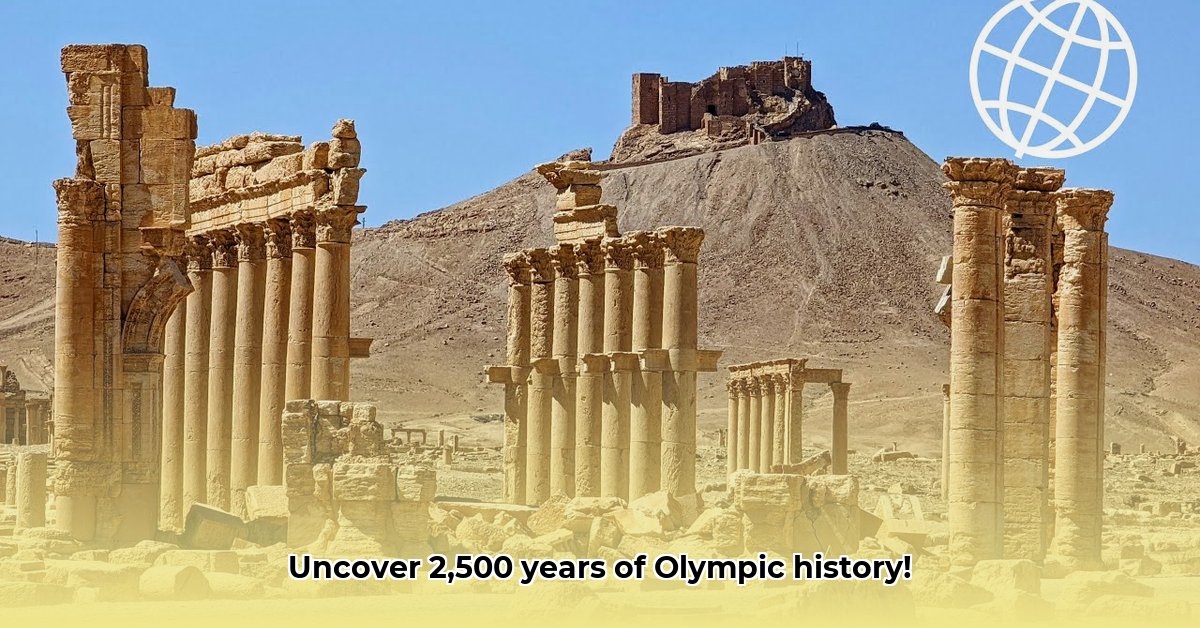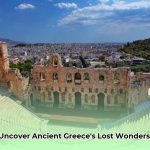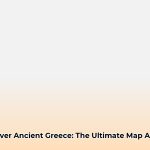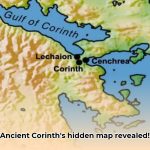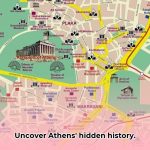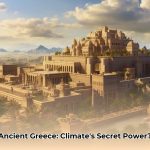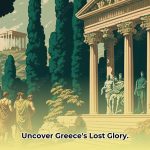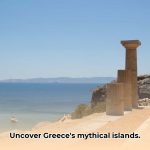Venture into the heart of ancient Greece and explore Olympia, the sacred birthplace of the Olympic Games. This comprehensive guide unveils the secrets of this archaeological marvel, tracing its evolution through millennia with insights into its history, religious significance, and athletic prowess. For a visual reference, check out this Ancient Greece map.
Ancient Olympia: A Journey Through Time
Olympia, officially known as Archaia Olympia, resides in Elis on the Peloponnese peninsula. More than just a location, Olympia was a Panhellenic sanctuary, host to the Olympic Games every four years from the 8th century BC to the 4th century AD. Rediscovered and restored in 1894, Olympia symbolizes international collaboration and the pursuit of excellence.
The Altis: Sacred Heart of Olympia
The Altis, a sacred precinct dedicated primarily to Zeus, housed temples and monuments. This area served as the epicenter of religious and athletic activities. Although dedicated to Zeus, various other deities were worshipped here, emphasizing the polytheistic nature of ancient Greek religion. The Altis was not merely a collection of buildings, but a physical manifestation of Greek religious beliefs.
Key Structures within the Altis:
-
Temple of Zeus: The largest and most important building in Olympia, designed by Libon of Elis around 460 BCE, signified the prominence of Zeus in Greek society. Inside stood the Statue of Zeus, a chryselephantine sculpture by Phidias, celebrated as one of the Seven Wonders of the Ancient World.
-
Temple of Hera (Heraion): One of the oldest Doric temples, initially shared by Hera and Zeus, signifying the importance of Hera in the Greek pantheon. Constructed around 600 BCE, it predates the Temple of Zeus, indicating early reverence for Hera.
-
Pelopion: A sanctuary dedicated to the hero Pelops, reflecting the importance of local heroes and mythological figures in Olympia’s religious landscape.
-
Philippeion: A circular memorial building dedicated by Philip II of Macedon, completed by Alexander the Great, symbolizing Macedonian influence over Olympia in the 4th century BCE.
-
Metroon: Temple dedicated to the Mother of the Gods (Cybele), later repurposed to house statues of Roman emperors, reflecting the shift in power during the Roman period.
The Stadium: Where Legends Were Born
The stadium was the epicenter of athletic competition. Originally a simple field, it evolved over centuries to accommodate tens of thousands of spectators. The stadium embodies the Greek dedication to athletic excellence.
Key Features of the Stadium:
-
Starting Blocks: Marble blocks with notches for runners’ feet, ensuring fair starts.
-
Judges’ Platform: Stone seats reserved for the Hellanodikai.
-
Track Length: Approximately 192 meters, becoming the standard ancient Greek unit of distance known as the stadion.
Evolution and Modifications:
The stadium underwent several transformations, reflecting the growing popularity and importance of the Olympic Games. Restorations emulate the 4th century BCE version, showcasing the stadium’s historical continuity.
Daily Life in Olympia: Beyond the Games
Olympia was not just a venue for the games. The presence of workshops, hostels, and administrative buildings highlighted the daily lives of athletes, trainers, and visitors.
Key Structures for Daily Life:
-
Palaestra: A training ground for wrestlers and boxers, showing dedication to athletic preparation.
-
Gymnasium: Included a covered running track, essential for maintaining fitness.
-
Leonidaion: A large guesthouse for visiting dignitaries.
-
Prytaneion: Housed a perpetual fire and served as a banquet hall for Olympic victors.
-
Baths: Essential for hygiene and relaxation, reflecting attention to athletes’ well-being.
Roman Influence on Olympia
The Romans significantly impacted Olympia, adding new structures and modifying existing ones. The Roman influence underscores the site’s integration into the Roman Empire.
Notable Roman Additions:
-
Villa of Nero: Reflecting Nero’s personal interest in the Olympic Games.
-
Nymphaion of Herodes Atticus: An elaborate fountain demonstrating Roman engineering and ornamental styles.
-
South Baths: Expanded bathing facilities, reflecting Roman culture.
Archaeological Discoveries and Significance
Ongoing excavations at Olympia reveal invaluable artifacts and insights into its past. These findings enrich our understanding of ancient Greek life.
Notable Discoveries:
-
Phidias’ Workshop: Identified by a cup inscribed “I belong to Phidias,” providing insights into his methods and the creation of the Statue of Zeus.
-
Votive Offerings: Excavated votive offerings show the religious practices and the cultural values of the time.
-
Weaponry: A collection of ancient Greek weapons, the largest in the world, providing insights into ancient warfare and dedicated offerings.
The Enduring Legacy of Olympia
Olympia’s legacy extends far beyond its ancient ruins. It stands as a symbol of athletic competition, religious devotion, and cultural exchange. Its rediscovery and ongoing study continue to inspire and inform, making it a treasure trove of historical knowledge and a testament to human achievement.
How Did Political Maneuvering Impact the Ancient Olympic Games at Olympia?
Olympia, the birthplace of the Olympic Games, was not just a venue for athletic competition. Examining ancient sources and archaeological evidence reveals a complex interplay of politics, diplomacy, and power struggles that influenced the Games and their participants.
The Sacred Truce (Ekecheiria) and its Violations
The ekecheiria, or sacred truce, aimed to ensure safe passage for athletes and spectators traveling to Olympia. This truce, however, was frequently tested and sometimes violated.
-
Xenophon describes instances where city-states used the Games as an opportunity for political maneuvering, even during the truce.
-
Thucydides notes that the illusion of peace provided by the ekecheiria often masked underlying tensions and rivalries.
Control of Olympia: A Prize to be Won
Control of Olympia brought prestige and influence, turning the Games into a political tool.
-
Pausanias recounts disputes between Elis and Pisa over the management of the sanctuary. Elis eventually gained control in 572 BCE, underscoring the importance of holding the Games for political leverage.
-
The construction of treasuries by various city-states along the slopes of Mount Cronus was not just about honoring Zeus; it was a visible display of wealth and power.
The Stadium: A Stage for Political Messaging
The stadium, with its capacity to hold over 40,000 spectators, served as a powerful stage for political messaging.
-
Victories by athletes from a particular city-state were celebrated as a testament to that city’s strength and divine favor.
-
The hellanodikai, or judges, held significant authority and their decisions could influence political perceptions.
Beyond Victories: Economic and Social Impact
The economic benefits of hosting and winning at the Olympic Games had significant political ramifications.
-
City-states invested heavily in training athletes, understanding that success at Olympia could boost their reputation and attract trade.
-
Olympic victors often received significant honors, further enhancing the political standing of their home city-states.
The Roman Era: Shifting Political Influence
The Roman conquest brought significant changes to the political landscape of Olympia.
-
Nero’s participation in the Games in 67 CE, though controversial, highlighted the importance the Romans placed on integrating themselves into Greek traditions.
-
The construction of Roman structures, such as the Villa of Nero and the Nymphaion of Herodes Atticus, reflected the shift in power and the desire of Roman rulers to leave their mark on Olympia.
Modern Discoveries and Their Significance
Archaeological discoveries continue to shed light on the political aspects of Olympia.
-
Inscriptions on votive offerings and monuments often provide insights into the political motivations behind their dedication.
-
The excavation of administrative buildings and council houses reveals the organizational structure of the Games and the political processes involved in their management.
Olympia’s Religious Rituals and the Olympic Games
The ancient Olympic Games were deeply intertwined with religious rituals, reflecting the sacred nature of the Olympia sanctuary. Discover the ceremonies, offerings, and sacred spaces that defined this spiritual dimension.
The Sanctuary’s Sacred Heart
The sanctuary at Olympia was a sacred space dedicated primarily to Zeus. The temple of Zeus housed a massive statue.
-
Pausanias describes the Temple of Zeus as housing the gold and ivory statue of Zeus.
-
Archaeological evidence confirms the presence of numerous altars and sacred groves within the Altis, underscoring the religious significance of the area.
Rituals and Sacrifices
Rituals and sacrifices were integral to Olympia’s Religious Rituals and the Olympic Games.
-
Animal sacrifices to Zeus and other deities were performed regularly at altars within the sanctuary.
-
Athletes often made vows and offerings to the gods, seeking divine favor before and after competitions. An oath was sworn to Zeus before the games.
The Role of Priests and Priestesses
Priests and priestesses played a crucial role in overseeing religious activities at Olympia.
- The priestess of Demeter Chamyne was the only woman allowed to watch the Olympic Games, highlighting the religious significance of her role.
The Olympic Flame
The Olympic flame, lit at the altar of Hera, symbolized the purity and spirit of the Games.
Festivals and Processions
Festivals and processions were important components of the religious celebrations at Olympia.
Roman Influence and Adaptation
The Roman era brought changes to the religious practices at Olympia.
- Roman emperors were often deified and honored with statues and temples.
- While traditional Greek religious practices continued, they were often integrated with Roman religious customs.
Modern Discoveries and Insights
Archaeological discoveries continue to enhance our understanding of the religious aspects of Olympia
- Excavations have revealed numerous votive offerings, providing insights into the beliefs and practices of the athletes and worshippers.
- Inscriptions on altars and temples offer valuable information about the deities honored at Olympia.
Political Power Dynamics in Ancient Olympia’s Development
Olympia’s development was significantly shaped by political power dynamics among ancient Greek city-states and later by the Roman Empire.
Early Olympia: Seeds of Power
The early development of Olympia was influenced by the competition between Elis and Pisa for control of the sanctuary.
The Classical Era: City-State Rivalry
The classical era saw Olympia rise to prominence as a Panhellenic center.
-
City-states constructed treasuries within the Altis.
-
The Games served as a stage for city-states to display their wealth, power, and cultural achievements.
Alliances and Conflicts
Alliances and conflicts among city-states often played out at Olympia.
The Rise of Macedon
Philip II of Macedon’s victory over the Greeks at Chaeronea in 338 BCE marked a turning point in Olympia’s history.
Roman Influence and Control
The Roman conquest of Greece in 146 BCE brought Olympia under Roman control.
-
Roman emperors often visited Olympia and participated in the Games.
-
Roman officials oversaw the administration of the sanctuary.
Decline and Abandonment
The decline and eventual abandonment of Olympia were influenced by political and economic factors.
- Explore the Marathon Ancient Greece Map: A New Perspective on the Iconic Battle - August 12, 2025
- Explore Ancient Greece Drawings: Styles, Periods and Enduring Examples - August 12, 2025
- Ever Wondered About Toxic Truths? Makeup in Ancient Greece Unveiled! - August 12, 2025
